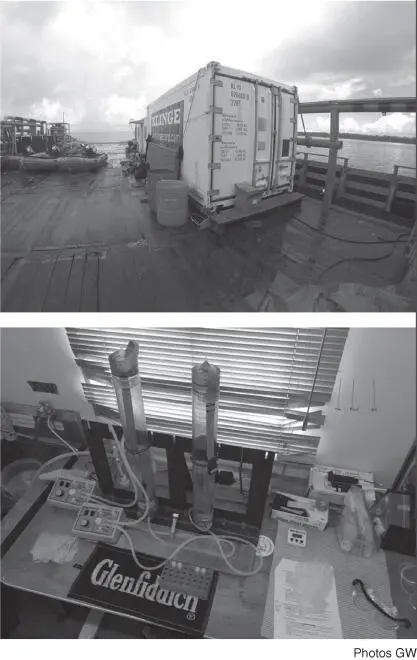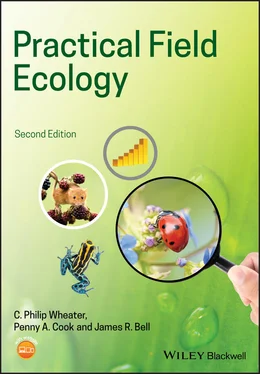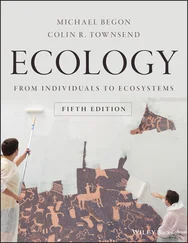Box 1.2 Suggested minimum equipment required for fieldwork
Always recommended
First aid kit.
Map(s) of the area.
Paper for recording (preferably in notebook form and waterproof if possible).
Pencils and sharpener (avoid ink if possible; even waterproof inks can run when wet).
Mobile (cell) phone (fully charged and with spare batteries).
Whistle.
Compass or global positioning system (GPS) receiver.
Watch.
Appropriate clothing and footwear.
Appropriate safety equipment (e.g. gloves, safety glasses, etc.).
Appropriate sampling equipment (nets, traps, plastic tubes, plastic bags). NB: put any samples in a double plastic bag and label each bag so that if one label does come off, the other is there for reference. Whilst some marker pens may be reasonably waterproof, because of the risk of the ink running or rubbing off, it is better to add a label to each bag using waterproof paper marked with a soft pencil).
Recommended depending on terrain, weather, and timing and extent of work
Survival bag.
Emergency food.
Torch (fully charged and with spare batteries).
If working outside of your usual comfort zone, for example in locations overseas, check with researchers or organisations (e.g. The Royal Geographical Society of London 21 ) who have experience of working in such countries or habitat types. The travel advice section of the UK Foreign Office website provides up to date information which can help to plan and implement risk assessments for overseas work. 22 Even within your sphere of experience, avoid complacency, since conditions may change and even small risks can be hazardous.
Once the legal, ethical, and health and safety issues have been properly examined, it is important to address these through a thorough formal risk assessment process. Most organisations have their own risk assessment proformas and a protocol for producing and checking them. Remember that you should include any hazards that you envisage could occur, together with appropriate equipment and actions (including training) that should help to mitigate the level of risk. All members of the team implementing the work should be fully briefed on the risk assessment and be comfortable that the work in which they will participate is within their skill level. Include within the risk assessment pack any additional information, such as details of important contacts, relevant COSHH material, appropriate first aid information, etc. It is important to recognise that risk assessments are dynamic, working documents that should be revisited and amended where necessary during all phases of the project implementation (especially if issues do arise). When issues do occur, they need to be recorded and any actions taken fully documented. USHA/UCEA (2011) include a list of possible hazard types that should be considered.
You will need to complete a thorough literature search and possibly even consult other scientists experienced in the field of your proposed research in order to appropriately define and refine the appropriate methods for your study. There will usually be a balance between the ideal solution in terms of the methods used, and logistical restrictions of time, and availability of equipment and expertise. Work through all the logistical aspects you can, well in advance of final implementation, to reduce the possibility that there will be significant problems and delays. This is especially important where there is a large team of researchers involved, where the field sites and/or techniques are relatively novel to you, and where equipment and specimens require transporting, especially overseas. Case Study 1.2discusses an example of how one research team dealt with the creation of appropriate facilities in difficult environmental conditions and successfully brought their samples home. Provided that your project has been well designed, and pilot studies have enabled you to refine your techniques, the implementation of the project should be straightforward. Here, we emphasise the importance of careful note taking and time management during your project. It is important that all participants are thoroughly briefed on the project, its risks, methods, lines of communication, actions to be taken in the event of any problems, etc., before implementation.
Case Study 1.2 Processing and transporting marine microbes from one of the most remote places on earth
 Temporary microbiological laboratory on board ship.
Temporary microbiological laboratory on board ship.
Gareth Williams is a Reader (Associate Professor) in Marine Biology based within Bangor University's School of Ocean Sciences in the UK. Much of his work involves collecting data from very remote parts of the planet where conditions are challenging and where there are extremely limited resources on hand. This case study deals with the challenges of processing and transporting marine microbe samples collected at remote reefs in the Indian Ocean.
Model organism and research challenges faced
Marine microbes are an extremely interesting group of organisms; what they are and what they are doing can offer valuable insight into the health of marine ecosystems such as coral reefs. Here, Gareth and his team were interested in sampling marine microbes living in the water column above coral reefs within the Chagos Archipelago, a remote group of oceanic atolls and islands spanning over 200 km of latitude in the remote Indian Ocean. In fact, the coral reefs of the Chagos Archipelago are arguably some of the most remote coral reefs on Earth and form one of the world's largest Marine Protected Areas.
After travelling from the UK to Bahrain and on to a military base on the island of Diego Garcia located within the Chagos Archipelago, the team boarded the British Indian Ocean Territory's enforcement vessel, the Grampian Frontier.
This was to be their home and science platform for the next 4 weeks and they set sail to survey 29 reefs across the Archipelago, including collecting near‐reef water microbial samples. The first challenge arose when attempting to carry out sample processing on a ship designed with cold climates and oily rescues in mind, rather than tropical temperatures and sterile laboratory conditions. This presented a significant problem: how to construct a temporary microbiology laboratory where they could process, freeze, and store samples on such a vessel. The second challenge was to then determine how to transport frozen seawater samples (that contained the microbes) back from Chagos, through Bahrain and then on to the UK, without the samples melting in temperatures regularly exceeding 40 °C.
How the challenge was resolved
Fortunately, the team had managed to ship liquid nitrogen ahead of time and the majority of it had amazingly survived the long, warm ship transit from Singapore to Diego Garcia. This allowed them to flash‐freeze seawater samples – a crucial part of the processing protocol. However, things only stay frozen if kept below 0 °C. The ship's cook kindly agreed to allow Gareth to store the frozen samples (and the liquid nitrogen) in a large walk‐in freezer on the back deck of the ship, as long as they were properly contained and away from any food. Problem solved.
The next challenge was to construct a laboratory. The solution was to turn a deck container that had been sweltering and rotting in the heat of the tropics for the best part of a year into a workable space for microbiology – a discipline that demands consistently sterile working conditions. This required ethanol, lots of ethanol, a cloth, and some good old‐fashioned elbow grease. Ethanol, fortunately, was not in short supply. Having sectioned off a portion of the container and cleaned it repeatedly, this appeared to solve the problem – provided Gareth repeated the cleaning frenzy on an almost daily basis. Asking the other scientists nicely to stay away from the area with their wet and dirty equipment was also very crucial.
Читать дальше

 Temporary microbiological laboratory on board ship.
Temporary microbiological laboratory on board ship.










